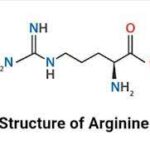Arginine Amino Acid structure representation is the main purpose of this study. This article would create complete idea about the structural formation of this amino acid with chemical descriptions with the details explanations.
The facts reflected by the structure are very important to identify the different type of structures of the Amino Acids. This compound comes under the Alpha Amino Acids, which denotes that the groups are held by one centralised carbon atom in the compound.
Arginine Amino Acid Structure
In this section the structural; appearance if the compound would be described with detail information about the bonds, groups and other organic features held by the compound.
The Alpha Amino Acid is consists of three groups that are one Alpha Amino group, an Alpha carboxylic group and at the end of the side chain a guanidinium group. These are found to be connected with an aliphatic straight chain of three carbons. The chemical formula of the Amino acid is C6H14N4O2.
The structure consists of three carbons in chain form and the chain is aliphatic chain. Aliphatic refers to a type of hydrocarbon compounds, which generates open-chain compounds. It can hold both single and double bonds.
In Arginine, there are two single bonds, one holds one oxygen atom and another one holds an amino group. The aliphatic chain has been found at one sides and the distil end has one Guanidinium group. Guanidine is another type of compound which hold chemical formula as HNC(NH2)2, which is clearly showing the presence of two Amino groups.
C=NH group present in this Amino acid contributes on carbon to the compound. The pKa of this compound is 13.8. pKa refers to the constant that denotes the acidic dissociation of the compound. The carboxylic acid present in this compound can dissociate with the rate of 13.8 in any polar solution.
This Alpha Amino Acid is found to get protonated structure and represent physiological pH level being positively charged. The protonated structure takes place due to the conjugation that appears between the double bond and the lone pair present in the Nitrogen of Amino group.
The delocalised positive charges that can be found in the compound are responsible for driving the element to form the multiple hydrogen bonds. These bonds are the single bonds in this compound. Otherwise, the C-C bonds are also found to be single bonds.

Facts represented by the structure of Arginine
Some facts are reliably represented by the structure of the Amino Acid. The characteristic of this Amino acid can be defined by this structure which is quite unique and effective to described the internal matter happens in its synthesis process.
Arginine is also known as L-Arginine. However, the presence of aliphatic chain gives it another name that is Aliphatic Amino Acid. This unique amino acid has been found to participate as precursor in Biosynthesis of Nitric Acid.
The straight aliphatic chain tin this Amino Acid enhances the stability of the compound. However, it has been found that scientists Schulze and Winterstein produced arginine from omithine and cyanamide. The structure that was invented by them placed some doubts about the actual structure of the amino acid.
The contrary comments on the debate about the structural definition of Arginine represent the Alpha Amino Acid structure by proving the presence of Alpha carbon in the compound. the Alpha carbon is only responsible for holding the functional groups in the compound and it participates in the aliphatic chain formation.
However the most relevant fact about the synthesis of arginine holds the information about the sequential action shown by the enzymes to make the Amino acid from protein metabolism and its citruline.
The structure gives the idea about the characteristic of the Amino Acid being the immediate precursor of NO. This second messenger (Arginine) handles the vasodilation process in human body by working on the immune system, as well. The compound is also a precursor of Urea.
The metabolites (L-citrulline, agmatine and L-ornithine) possessed by L-Arginine revels that they could make individual distinguishable groups this important fact also comes forward with the help of definition given by then Arginine Amino Acids structure.
Frequently Asked Questions (FAQs)
Question 1: What are the main metabolites holds by Arginine?
Answer: L-citrulline, agmatine and L-ornithine are the main metabolites in Arginine which shows a significant role to enhance the utilisable characteristics of the Alpha Amino Acid. These groups are responsible for creating distinguishable properties in the Amino Acid.
Question 2: Which functional groups are found in Arginine?
Answer: One carboxylic group and the amino group are the main functional group, this group show distinct property by existing as an Alpha groups being attached with the Alpha carbon.
Question 3: Which one is the Alpha carbon in the Alpha Arginine Amino Acid?
Answer: The carbon atom in the compound which holds the functional groups is called Alpha carbon. The carboxylic group is attached with the Alpha carbon.
Question 4: What is Arginine glutamate? Write its use.
Answer: The mixture of 50% of glutamic acid and 50% of Arginine is called Arginine glutamate. Basically, this is the mixture of two different Amino Acids. This mixture of Amino acids is used in Liver therapy in Human body.
Question 5: What is Arginine-citruline pathway?
Answer: The production of inducible NOS enhances the ability of Citruline to produce Arginine in marketing demands. A by-product from inducible NOS formed with the help of citruline, which allows the reaction to recycled the production of Arginine. This recycling pathway is called citruline-arginine pathway.

Hi…..I am Sarnali Mukherjee, a graduate from the University of Calcutta. I love to teach and share knowledge on chemistry. I have gradually gained interest in article writing since one year ago. I would love to acquire more knowledge on my subject in the future.
Let’s connect through LinkedIn: